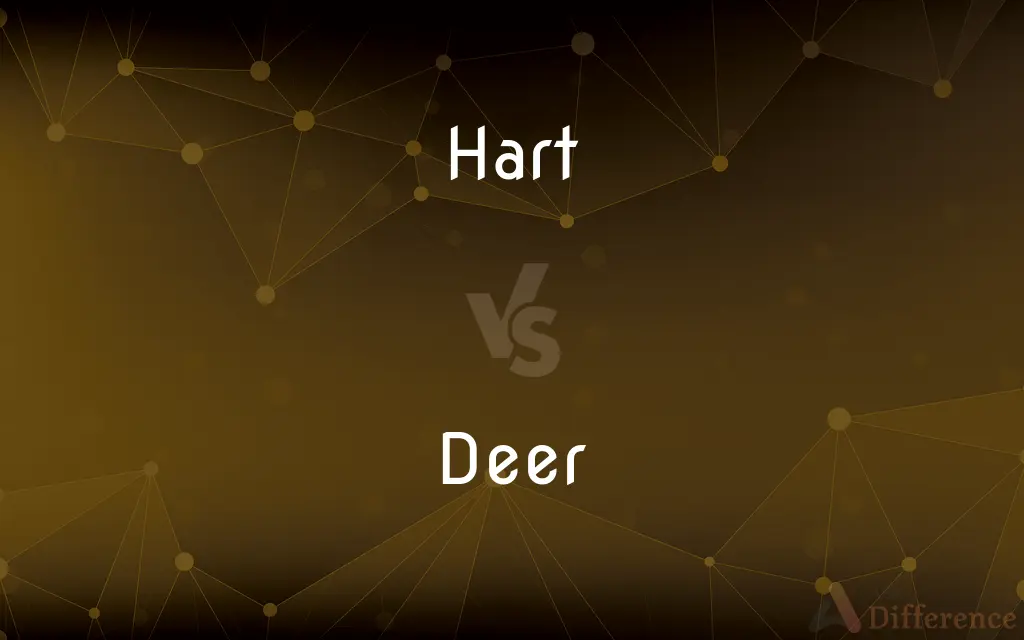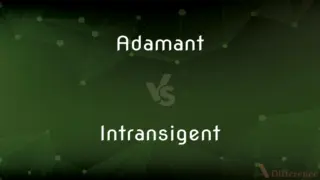Hart vs. Deer — What's the Difference?
By Tayyaba Rehman — Updated on November 4, 2023
A hart is specifically a mature male red deer over five years old, while the term 'deer' refers more broadly to any member of the family of wild or domesticated hoofed mammals with antlers.

Difference Between Hart and Deer
Table of Contents
ADVERTISEMENT
Key Differences
A hart is specifically an adult male deer, traditionally of the red deer species, particularly after its fifth year. It is a term that is not commonly used in everyday language and has an archaic, literary ring to it. Deer, in contrast, is the general term used to refer to the entire family of animals that includes a wide variety of species, such as the white-tailed deer, reindeer, and elk.
The word hart often appears in historical and literary contexts, reflecting an older English usage. The deer, however, is a much more common term, used in both contemporary and historical contexts. When we talk about deer in general, we do not specify the gender or the age of the animal, unlike when we specifically refer to a hart.
Harts are characterized by their antlers, which are typically larger and more branched with age, symbolizing maturity and strength. Conversely, deer can range from small, unadorned females (does) and young (fawns) to the large antlered males (bucks, stags, or harts, depending on the species and age).
In heraldry and traditional symbolism, the hart is often depicted as a noble creature, representing grace and virility. Deer, meanwhile, have a broader symbolic footprint, often representing gentleness and the untamed aspects of nature. Both terms evoke images of the wilderness and natural beauty, but the hart suggests a specific, majestic animal.
The distinction between a hart and deer becomes important in wildlife management, hunting, and ecology. While "deer" could refer to any member of the family, managing a population of harts would involve specific considerations of the mature males in a herd. This is because the behaviors and roles of harts within their communities differ significantly from other deer.
ADVERTISEMENT
Comparison Chart
Definition
An adult male red deer, especially after its fifth year.
A family of hoofed mammals that includes many different species.
Usage
Archaic and specific to mature male red deer.
Common and refers to all genders and ages.
Antlers
Typically larger and well-branched, signifying age and maturity.
Varies widely; females generally do not have antlers.
Symbolism
Represents nobility, virility, and strength.
Often symbolizes gentleness and the wild.
Gender and Age
Refers only to mature males.
Includes all genders and ages: males, females, and young.
Compare with Definitions
Hart
A hart is a mature stag, particularly a red deer aged five years or older.
The majestic hart stood at the forest edge, surveying its territory.
Deer
Deer species vary greatly in size, from the small muntjac to the large moose.
The deer in this region include both the diminutive white-tailed deer and the imposing elk.
Hart
A hart's antlers are a distinct feature, usually larger and more complex than younger stags.
The hart's antlers spread wide, a testament to its years.
Deer
Female deer are typically called does, and young deer are known as fawns.
The doe led her fawns carefully through the underbrush.
Hart
A hart is also featured in heraldry, representing a variety of virtues.
The family crest was emblazoned with a hart, symbolizing honor and longevity.
Deer
Deer are adapted to diverse habitats, from forests to tundras.
Deer have been spotted in the densest woods and the coldest arctic zones.
Hart
Historically, the term hart was commonly used in medieval hunting terminology.
Knights set out into the woods to hunt the elusive hart.
Deer
Deer or true deer are hoofed ruminant mammals forming the family Cervidae. The two main groups of deer are the Cervinae, including the muntjac, the elk (wapiti), the red deer, the fallow deer, and the chital; and the Capreolinae, including the reindeer (caribou), the roe deer, the mule deer, and the moose.
Hart
In literature, a hart is often symbolic of regality and the untamed natural world.
The prince bore the emblem of a hart to signify his courage and nobility.
Deer
Any of various hoofed ruminant mammals of the family Cervidae, characteristically having deciduous antlers borne chiefly by the males. The deer family includes the white-tailed deer, elk, moose, and caribou.
Hart
An adult male deer, especially a red deer over five years old.
Deer
A ruminant mammal with antlers and hooves of the family Cervidae, or one of several similar animals from related families of the order Artiodactyla.
Hart
A male deer, especially a male red deer over five years old.
Deer
(in particular) One of the smaller animals of this family, distinguished from a moose or elk
I wrecked my car after a deer ran across the road.
Hart
A male deer, especially the male of the red deer after his fifth year.
Deer
The meat of such an animal; venison.
Oh, I've never had deer before.
Hart
A male red deer or one of related species.
Deer
Any animal, especially a quadrupedal mammal as opposed to a bird, fish, etc.
Hart
Obsolete spelling of heart
Deer
Any animal; especially, a wild animal.
Mice and rats, and such small deer.
The camel, that great deer.
Hart
A stag; the male of the red deer. See the Note under Buck.
Goodliest of all the forest, hart and hind.
Deer
A ruminant of the genus Cervus, of many species, and of related genera of the family Cervidæ. The males, and in some species the females, have solid antlers, often much branched, which are shed annually. Their flesh, for which they are hunted, is called venison.
Hart
United States playwright who collaborated with George S. Kaufman (1904-1961)
Deer
Distinguished from Bovidae by the male's having solid deciduous antlers
Hart
United States lyricist who collaborated with Richard Rodgers (1895-1943)
Deer
Deer are hoofed, grazing mammals known for their graceful appearance.
A family of deer grazed quietly in the meadow.
Hart
Male red deer
Deer
The term deer refers to both the singular and plural form of the species.
A solitary deer can often be as captivating as a group of deer in the wild.
Common Curiosities
Are all male deer called harts?
No, only mature red deer males are typically called harts.
Is "hart" a commonly used term?
No, "hart" is an archaic term and is rarely used in modern language.
What is a hart?
A hart is a fully mature male red deer, especially one over five years old.
What types of deer can be called a hart?
The term "hart" is traditionally used for male red deer.
Do harts and deer have antlers?
Mature male deer, including harts, have antlers, but female deer usually do not.
Why might someone use the term hart instead of deer?
"Hart" might be used for poetic or historical effect, or to specifically refer to a mature male red deer.
Are deer herbivores?
Yes, all deer are herbivores and primarily graze on vegetation.
Can the term deer refer to both male and female animals?
Yes, "deer" is a general term that refers to both male and female animals of that species.
Is a young deer ever referred to as a hart?
No, young deer are called fawns, not harts.
How is the term deer used in the plural?
"Deer" is the same in both singular and plural forms.
Can the term hart refer to non-red deer species?
Traditionally, the term hart is specific to red deer, though it can sometimes be used for other species.
Are harts protected animals?
Protection status varies by location and species, but many mature stags, including harts, are subject to wildlife conservation laws.
In what context might I encounter the term hart?
You might encounter "hart" in historical texts, literature, or when discussing specific wildlife management issues.
Do all deer species live in the same habitats?
No, deer species are adapted to a variety of habitats around the world.
Can the term deer refer to domesticated animals?
Yes, "deer" can refer to both wild and domesticated members of the deer family.
Share Your Discovery

Previous Comparison
Adamant vs. Intransigent
Next Comparison
Usage vs. CustomAuthor Spotlight
Written by
Tayyaba RehmanTayyaba Rehman is a distinguished writer, currently serving as a primary contributor to askdifference.com. As a researcher in semantics and etymology, Tayyaba's passion for the complexity of languages and their distinctions has found a perfect home on the platform. Tayyaba delves into the intricacies of language, distinguishing between commonly confused words and phrases, thereby providing clarity for readers worldwide.
















































